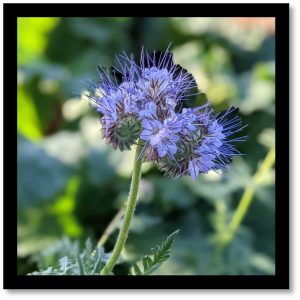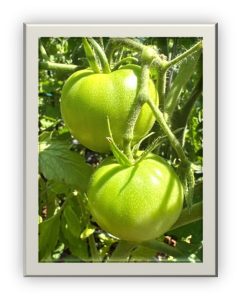 Compiled by Susan Hoehn
Compiled by Susan Hoehn
A big thank you to all who contributed
to this column!
*I rake all my leaves into the garden area and the flower beds. I find several types of birds will come through – flipping leaves with their little feet, looking for bugs all winter! —Dee Copley, MG 2014
*Save yourself some labor in the spring by planting a cover crop in the fall. I’m using Lacy Phacelia in between planted areas in my pollinator garden. It should serve as a weed barrier through the wet months and early spring — as well as an early-blooming and readily reseeding flower for pollinators. In the spring, I will simply dig out any areas that I want to fill with new plantings, and leave the rest of the Lacy Phacelia as a filler, pollinator flower and soil amendment. This attractive purple flower fixes nitrogen in the soil. Fellow apiphiles: this crop attracts Van Dyke’s Bumblebees, whose males are bright yellow, in large numbers! — Erin Galbraith
garden. It should serve as a weed barrier through the wet months and early spring — as well as an early-blooming and readily reseeding flower for pollinators. In the spring, I will simply dig out any areas that I want to fill with new plantings, and leave the rest of the Lacy Phacelia as a filler, pollinator flower and soil amendment. This attractive purple flower fixes nitrogen in the soil. Fellow apiphiles: this crop attracts Van Dyke’s Bumblebees, whose males are bright yellow, in large numbers! — Erin Galbraith
*We have lived here for 47 years and had a garden every year. In the fall, after all plants and vines are removed, we cover it all with a deep layer of leaves: leaves that I rake up, and leaves the neighbors have bagged up. (That is a win-win for us both, as we do not have city leaf pick-up.) In spring we rototill and, voila!! The leaves have all disappeared!!
We do have good soil—not clay, but we do have millions of small stones in the soil. Or so it seems! — Liz Koester
*In general, I leave fall clean-up of my yard until March, when air temperatures are above 50 degrees F. That way, I know most or all of the stem-nesting bees have emerged. I leave my leaves as much as possible where they fall, or under shrubs and in the paths between my vegetable beds. I never compost, shred or bag them, as they are habitat for many beetles, larvae, moths, chrysalises of butterflies and even adult butterflies – and those provide winter food for birds. When I cut the stems, I lay them gently in my ornamental beds as mulch, so that all the native bees can emerge.
 *My vegetable garden beds either get covered with leaf habitat (it’s not litter) or planted with green manure cover crops: crimson clover, winter pea and grass mix, and always Phacelia tanacetifolia (Lacy Phacelia). It blooms until heavy frost, provides great winter cover and blooms in spring and summer for native bees and beneficial insects. It’s a better companion plant in your veggie garden than marigolds! — Lynn Kunstman
*My vegetable garden beds either get covered with leaf habitat (it’s not litter) or planted with green manure cover crops: crimson clover, winter pea and grass mix, and always Phacelia tanacetifolia (Lacy Phacelia). It blooms until heavy frost, provides great winter cover and blooms in spring and summer for native bees and beneficial insects. It’s a better companion plant in your veggie garden than marigolds! — Lynn Kunstman
*Clean and sharpen tools, put away movable drip water systems in metal trash storage cans, and move all frost-sensitive plants inside beneath a light source.
*Prune back all cane berries and strawberries. Mulch any root vegetables left to winter in the ground like beets, carrots, potatoes.
*Prune plant parts away from ground for easier flow of leaf blowing. Blow leaves into piles. If left, they can cause disease around plants that don’t like being buried in winter, and cane berry/rose leaves can carry diseases. Use a backpack leaf blower, or rake. Leaves are blown to vegetable planting areas and leveled in a thick layer. My Jack Russells race through and crush them, so they disintegrate quickly. Dry leaves must be cleaned up since they’re summer fire hazards in our area.
*Spray autumn fungicide copper soap on plants that need it (stone fruits, pyracantha).
*Root establishment is better for autumn planted perennials like fruit trees, grapes, hardy kiwi, cane and blueberries, and ornamental shrubs.
*Do autumn spraying, remove young weeds before they make seed, shield stone fruit trees from rain/snow to keep leaf curl away. Pot up new plant starts. — Jordan and the Two JRTs


 years, they are providing the perfect summer peaches and nectarines.
years, they are providing the perfect summer peaches and nectarines. about 6 feet tall, that bush gave and gave this year. But what to do? I made Elderberry Syrup. Caution: Fresh elderberries, stems and leaves contain toxins. Do not eat raw. When cooked properly though, elderberries contain a very valuable antitoxin. – Mary Schrouder, Class of 2024
about 6 feet tall, that bush gave and gave this year. But what to do? I made Elderberry Syrup. Caution: Fresh elderberries, stems and leaves contain toxins. Do not eat raw. When cooked properly though, elderberries contain a very valuable antitoxin. – Mary Schrouder, Class of 2024
 If your plants are looking slightly wilted late in the heat of the day, that’s not necessarily a sign that water is needed. Check the soil first. On the other hand, if they are wilted in the morning and they don’t have any disease, they are in need of water. — Advice Jane learned from the Practicum
If your plants are looking slightly wilted late in the heat of the day, that’s not necessarily a sign that water is needed. Check the soil first. On the other hand, if they are wilted in the morning and they don’t have any disease, they are in need of water. — Advice Jane learned from the Practicum in the season, I may also add 12-6-6 liquid fertilizer as needed. — Sean
in the season, I may also add 12-6-6 liquid fertilizer as needed. — Sean Do you think you have an obsession with plants? Wait until you read about Hope Jahren! In her incredibly well-written memoir “Lab Girl”, Dr. Jahren affords us front-row seats into her fascinating personal and professional journey as a paleobiologist.
Do you think you have an obsession with plants? Wait until you read about Hope Jahren! In her incredibly well-written memoir “Lab Girl”, Dr. Jahren affords us front-row seats into her fascinating personal and professional journey as a paleobiologist.
 Oregon State University Extension
Oregon State University Extension
